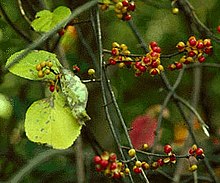Celastraceae
Appearance
| Celastraceae | |
|---|---|

| |
| Oriental staff vine (Celastrus orbiculatus) | |
| Scientific classification | |
| Kingdom: | Plantae |
| Clade: | Tracheophytes |
| Clade: | Angiosperms |
| Clade: | Eudicots |
| Clade: | Rosids |
| Order: | Celastrales |
| Family: | Celastraceae R.Br.[1] |
| Subfamilies[2] | |
The Celastraceae (syn. Brexiaceae, Canotiaceae, Chingithamnaceae, Euonymaceae, Parnassiaceae, Siphonodontaceae, and Stackhousiaceae), are a family (the staff vine or bittersweet family) of 96 genera and 1,350 species[3] of herbs, vines, shrubs and small trees, belonging to the order Celastrales. The great majority of the genera are tropical, with only Celastrus (the staff vines), Euonymus (the spindles) and Maytenus widespread in temperate climates, and Parnassia (bog-stars) found in alpine and arctic climates.
The roughly 100 genera include (with common names of some members):
- Canotia – crucifixion thorn
- Catha – khat
- Celastrus – staff vine or staff tree
- Euonymus – spindle
- Maytenus – maiten
Genera
A complete list of the genera is:
- Acanthothamnus
- Allocassine
- Anthodon
- Apatophyllum
- Apodostigma
- Arnicratea
- Bequaertia
- Brassiantha
- Brexia
- Brexiella
- Campylostemon
- Canotia
- Cassine
- Catha
- Celastrus
- Cheiloclinium
- Crocoxylon
- Crossopetalum
- Cuervea
- Denhamia
- Dicarpellum
- Dinghoua
- Elachyptera
- Elaeodendron
- Empleuridium
- Euonymus
- Euonymopsis
- Fraunhofera
- Gloveria
- Glyptopetalum
- Goniodiscus
- Gyminda
- Gymnosporia
- Hartogiella
- Hartogiopsis
- Hedraianthera
- Helictonema
- Hexaspora
- Hippocratea
- Hylenaea
- Hypsophila
- Kokoona
- Lauridia
- Lepuropetalon
- Loeseneriella
- Lophopetalum
- Lydenburgia
- Macgregoria
- Maurocenia
- Maytenus
- Menepetalum
- Microtropis
- Monimopetalum
- Mortonia
- Moya
- Mystroxylon
- Nicobariodendron
- Orthosphenia
- Parnassia
- Paxistima
- Peripterygia
- Peritassa
- Plagiopteron
- Platypterocarpus
- Plenckia
- Pleurostylia
- Polycardia
- Prionostemma
- Pristimera
- Psammomoya
- Pseudocatha
- Pseudosalacia
- Ptelidium
- Pterocelastrus
- Putterlickia
- Quetzalia
- Reissantia
- Robsonodendron
- Rzedowskia
- Salacia
- Salacighia
- Salaciopsis
- Salvadoropsis
- Sarawakodendron
- Scandivepres
- Schaefferia
- Semialarium
- Simicratea
- Simirestis
- Siphonodon
- Stackhousia
- Tetrasiphon
- Thyrosalacia
- Tontelea
- Torralbasia
- Tricerma
- Tripterococcus
- Tripterygium
- Tristemonanthus
- Wimmeria
- Xylonymus
- Zinowiewia
- Fossil genera


References
- ^ Angiosperm Phylogeny Group (2009). "An update of the Angiosperm Phylogeny Group classification for the orders and families of flowering plants: APG III". Botanical Journal of the Linnean Society. 161 (2): 105–121. doi:10.1111/j.1095-8339.2009.00996.x.
- ^ "Celastraceae R. Br., nom. cons". Germplasm Resources Information Network. United States Department of Agriculture. 2003-01-17. Archived from the original on 2009-05-06. Retrieved 2009-04-16.
- ^ Christenhusz, M. J. M.; Byng, J. W. (2016). "The number of known plants species in the world and its annual increase". Phytotaxa. 261 (3): 201–217. doi:10.11646/phytotaxa.261.3.1.
{{cite journal}}: Unknown parameter|lastauthoramp=ignored (|name-list-style=suggested) (help)
Wikimedia Commons has media related to Celastraceae.
